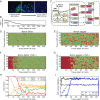Toward understanding cancer stem cell heterogeneity in the tumor microenvironment
- PMID: 30587589
- PMCID: PMC6320545
- DOI: 10.1073/pnas.1815345116
Toward understanding cancer stem cell heterogeneity in the tumor microenvironment
Abstract
The epithelial-mesenchymal transition (EMT) and cancer stem cell (CSC) formation are two paramount processes driving tumor progression, therapy resistance, and cancer metastasis. Recent experiments show that cells with varying EMT and CSC phenotypes are spatially segregated in the primary tumor. The underlying mechanisms generating such spatiotemporal dynamics in the tumor microenvironment, however, remain largely unexplored. Here, we show through a mechanism-based dynamical model that the diffusion of EMT-inducing signals such as TGF-β, together with noncell autonomous control of EMT and CSC decision making via the Notch signaling pathway, can explain experimentally observed disparate localization of subsets of CSCs with varying EMT phenotypes in the tumor. Our simulations show that the more mesenchymal CSCs lie at the invasive edge, while the hybrid epithelial/mesenchymal (E/M) CSCs reside in the tumor interior. Further, motivated by the role of Notch-Jagged signaling in mediating EMT and stemness, we investigated the microenvironmental factors that promote Notch-Jagged signaling. We show that many inflammatory cytokines such as IL-6 that can promote Notch-Jagged signaling can (i) stabilize a hybrid E/M phenotype, (ii) increase the likelihood of spatial proximity of hybrid E/M cells, and (iii) expand the fraction of CSCs. To validate the predicted connection between Notch-Jagged signaling and stemness, we knocked down JAG1 in hybrid E/M SUM149 human breast cancer cells in vitro. JAG1 knockdown significantly restricted tumor organoid formation, confirming the key role that Notch-Jagged signaling can play in tumor progression. Together, our integrated computational-experimental framework reveals the underlying principles of spatiotemporal dynamics of EMT and CSCs.
Keywords: Notch signaling; breast tumor organoids; cancer stem cells; epithelial–mesenchymal transition; inflammation.
Conflict of interest statement
The authors declare no conflict of interest.
Figures




Similar articles
-
A mechanism-based computational model to capture the interconnections among epithelial-mesenchymal transition, cancer stem cells and Notch-Jagged signaling.Oncotarget. 2018 Jul 6;9(52):29906-29920. doi: 10.18632/oncotarget.25692. eCollection 2018 Jul 6. Oncotarget. 2018. PMID: 30042822 Free PMC article.
-
Breast cancer growth and metastasis: interplay between cancer stem cells, embryonic signaling pathways and epithelial-to-mesenchymal transition.Breast Cancer Res. 2011 Jun 10;13(3):211. doi: 10.1186/bcr2876. Breast Cancer Res. 2011. PMID: 21672282 Free PMC article. Review.
-
Notch-Jagged signalling can give rise to clusters of cells exhibiting a hybrid epithelial/mesenchymal phenotype.J R Soc Interface. 2016 May;13(118):20151106. doi: 10.1098/rsif.2015.1106. J R Soc Interface. 2016. PMID: 27170649 Free PMC article.
-
Tumor microenvironmental signaling elicits epithelial-mesenchymal plasticity through cooperation with transforming genetic events.Neoplasia. 2013 Sep;15(9):1100-9. doi: 10.1593/neo.131114. Neoplasia. 2013. PMID: 24027434 Free PMC article.
-
Blockade of Jagged/Notch pathway abrogates transforming growth factor β2-induced epithelial-mesenchymal transition in human retinal pigment epithelium cells.Curr Mol Med. 2014 May;14(4):523-34. doi: 10.2174/1566524014666140331230411. Curr Mol Med. 2014. PMID: 24694299 Review.
Cited by
-
The road of NSCLC stem cells toward bone metastases.Bone Rep. 2022 Sep 5;17:101619. doi: 10.1016/j.bonr.2022.101619. eCollection 2022 Dec. Bone Rep. 2022. PMID: 36110341 Free PMC article.
-
MicroRNA-222 Regulates Melanoma Plasticity.J Clin Med. 2020 Aug 8;9(8):2573. doi: 10.3390/jcm9082573. J Clin Med. 2020. PMID: 32784455 Free PMC article.
-
Mechanical transmission enables EMT cancer cells to drive epithelial cancer cell migration to guide tumor spheroid disaggregation.Sci China Life Sci. 2022 Oct;65(10):2031-2049. doi: 10.1007/s11427-021-2054-3. Epub 2022 Mar 25. Sci China Life Sci. 2022. PMID: 35366152
-
Towards control of cellular decision-making networks in the epithelial-to-mesenchymal transition.Phys Biol. 2019 Mar 7;16(3):031002. doi: 10.1088/1478-3975/aaffa1. Phys Biol. 2019. PMID: 30654341 Free PMC article. Review.
-
Population Dynamics of Epithelial-Mesenchymal Heterogeneity in Cancer Cells.Biomolecules. 2022 Feb 23;12(3):348. doi: 10.3390/biom12030348. Biomolecules. 2022. PMID: 35327538 Free PMC article.
References
Publication types
MeSH terms
Substances
Grants and funding
LinkOut - more resources
Full Text Sources
Other Literature Sources

